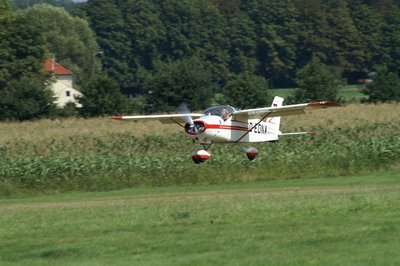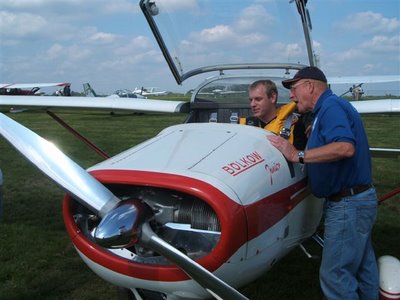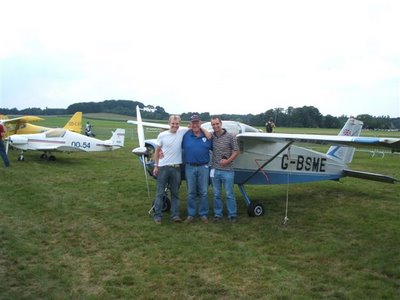The sun was just making an appearance as I left the house for the 90 minute drive to the airstrip where my (then) Bolkow Junior D-EDNA was based. The forecast was pretty good, so spirits were high as I negotiated my way around the (unusually clear) M25 and down the M3 towards Winchester. Arriving at the airstrip at 07:00hrs (L) I loaded my bag into the aeroplane and began to make preparation for my departure. I was on my own for the trip. My (then) fiancee, a firmly earth-bound soul, refused to come; and my housemate (usually up for most things) failed to secure a weekend pass from 'the boss'. Poor show.
Diest is approximately 250nm from my (then) home strip of Farley Farm in Hampshire, so within range for a direct flight. However, with no fuel at the strip, and with about half tanks, I needed to stop for fuel before I ventured across the Channel. The day before I happened upon the website for 'London Ashford Airport'. That's Lydd to you and I. They were offering tax/duty free Avgas for all international departures. London Ashford Airport is, of course, nowhere near London, but located on a headland directly on my intended route of flight. Ideal! Lydd opened at 09:00hrs (L), so I planned to arrive overhead at 08:55hrs (L).
Farley Farm has a single 800m runway (06/24). Huge trees placed strategically on the western threshold effectively reduce the distance available to around 650m when using 24. Bags of room for the Bolkow with one up, half tanks and an overnight bag. The strip sits right on the edge of the Solent CTA so once airborne it's advisable to contact Solent Radar for a FIS. This is especially important when leaving the area to the East as you cross the extended centreline of the active runway at range 8.5nm.
Clearing the area to the East, I tracked towards Petersfield, where the South Downs become very conspicuous. Running West/East, the Downs make an ideal 'follow me' sign for a good 30nm. The visability was good, with early morning mist and dew sitting in the low lying shadows of the hills - all very spectacular. So often overlooked, the scenery in this part of the country really is fantastic. Flying in the early hours brings many rewards; Such hours are exempt from the often turbulent and convective nature characteristic of an August day. It has fast become my favourite time to fly.
Leaving Solent behind, London Information became my companion for this first part of the trip. The headland at Seaford provided a constant reference as I parallelled the coast eastward. Passing Rye at around 08:50hrs (L) I gave Lydd a call, half expecting to hold in the area for 10 minutes or so. To my pleasant suprise, Lydd responded with joining instructions, and I gratefully accepted the invitation to proceed into the overhead. Upon reaching, I was advised to continue my descent for a ''tight right-hand circuit for 03'' and expect a late clearance. The fire truck was still doing its runway inspection, but would (should?) be clear. The circuit at Lydd can be quite tight due to the proximity of the Dungeness power station to the South of the field. Various Danger Areas also litter the headland, so it pays to plan your circuit carefully.
The requirement for a ''tight'' circuit meant that it was an ideal candidate for a glide approach. Speed back, flaps to 17° for the glide. 600ft at the 'Low Key' position abeam the numbers, checks complete (where's that clearance?) I turned in on the glide adopting the 'constant aspect' technique. ''Delta November Alpha, cleared to land Runway 03, wind light and variable'' is broadcast through my headset as I roll wings level 200ft on 'short' final. Flashing over the numbers, the Bolkow settled nicely onto the new tarmac after a short but satisfying float. 'I enjoyed that', I thought as I taxied to the parking area by the fire house. ''Delta November Alpha, welcome to Lydd, landing time zero one''.
After just 20 minutes, the aeroplane was refuelled, landing fees paid and I was back in the saddle starting up for the next sector. The service at Lydd was exemplorary, and at 77p a litre and a £10 landing fee, I taxied out with a huge grin.
Departing towards the sea, I was 'feet wet' just one minute after take-off. I decided to stay with Lydd for the crossing, and gave Calais a call mid-Channel. The weather was still good. Visability was in excess of 10km giving a workable horizon for the crossing. As many will know, local conditions can sometimes conspire against pilots making this crossing. The brightness of the morning sun can generate a fair amount of haze, and can 'smudge' the horizon when it's needed most. ''Bonjour Calais...'' in my most stereotypical 'Englishman speaking French' manner marked the FIR boundary. Advice and past experience told me it would be pointless calling Lille Approach, as they seldom take interest in small GA traffic. Calais Tower is often the better bet - and so it proved to be.

It was upon crossing the French coast that the visability began to deteriorate. It was still very bright, but there was a good amount of broken cloud at around 2500ft and it was certainly much more hazy. The entire sky was the characteristic milky irrediscence common to summer days. Perfectly flyable, but it certainly would increased the workload across this part of Northern France. Those familiar with this part of France will know that it is pretty featureless until you cross into Belgium and reach the urban areas of Ghent and Antwerp. D-NA had no GPS fitted at the time, so all navigation was done by map-reading and dead reackoning by compass and stop-watch.
I was passed onto Ostend for a FIS. Tiny villages passed underneath my wing as I made steady progress East. I could just about make out the town of Ypres, (in)famous for the bloddy battles of the Great War. Now, a place of pilgrimage, the area around Ypres is saturated with the graves of soldiers who fell during the Battle of the Somme.
It was only upon reaching the confluences of Ghent that my faith in my navigation was affirmed. From here onwards, the navigation element would become easier. There did remain, however, one final hurdle to overcome. In order to reach Diest, one must route accurately between the Antwerp and Brussels control zones. A narrow corridor approximately 2nm wide is all that prevents an unpopular 'zone bust'.
After safely negotiating the corridor, I began to make preparations for my arrival into Diest. As with any event of this nature (such as the PFA Rally), traffic can be very heavy, and proper planning is essential to ensure a safe and efficient arrival into the event. Procedure dictated that pilots obtained the ATIS as soon as possible before reaching the field. Unlike the PFA Rally, where there are mandatory arrival routes and procedures, Diest employs a fairly standard downwind join. This is the point where I wished I had another set of eyes in the cockpit as the workload increased dramatically.
The ATIS was giving Runway 26 as active, so I proceded to join downwind, keeping a good lookout for other traffic. There were aeroplanes everywhere! 'This is going to be interesting', I thought to myself as I completed my downwind checks. Turning base, number five to land. Speed back and settling in the approach configuration, frantically moving my head (bird like I'm sure) trying to acquire all the aircraft. A Harvard was circling on a long final, waiting for a gap to appear - he would slip in behind me. On final approach, still one ahead just completing its landing roll. Short final and the runway becomes clear, the Bolkow comes over the hedge and kisses the grass gracefully. I make sure to vacate as soon as is safe to do so and make my way over to a gentleman waving ping-pong bats at me.



(Gunther Butterweck arrives in D-EHAC)
'I'm here, and what a great flight it was'. I was immediately greeted by the rest of the Bolkow contingent, Gunther Butterweck and my father Derek. Hampson Snr had arrived in G-BSME from Rotterdam the night before and Gunther had flown D-EHAC from Bonn Hangelar earlier that morning. The people at Diest do a great job of looking after their guests and after booking in and closing the flight plan, we tucked into the long-standing, traditional Belgian dish...Frites et Mayonaisse!


(The Bolkow contingent - Colin Hampson, Gunther Butterweck & Derek Hampson)
We spent a good few hours looking around the aircraft park admiring the various vintage types that had made the trip. D-NA was due to have it's annual in the weeks following the fly-in and would have to go to Germany. Therefore, the plan was for my father and I to fly back to Rotterdam and swap aeroplanes there. I would take G-ME back to Blighty and my father would take care of the annual - thanks Dad!
Gunther departed at the same time, so spectators were treated to three Bolkows taxying out and departing in sequence. It was a short sector of some 80nm, and we would fly it in formation until we reached controlled airspace where I would drop back and we would arrive seperately.
As my father was rolling, I lined up behind and began to roll as G-ME got airborne. D-NA has a climb prop fitted so accelaration was good and I soon caught up with Hampson Snr in G-ME. We set up 90kt cruise settings (G-ME approx 2300-2350rpm, D-NA approx 2400rpm) and tracked North. We passed East abeam Seppe, and approaching ROMEO I pealled away and dropped back out of formation.


Rotterdam publishes mandatory VFR routes both inbound and outbound to the field. ROMEO is a large railway yard on the southern edge of the city. The inbound route follows a motorway up to a large junction to the south-east of the airport. From here, aircraft proceed to a position south abeam the field and turn to cross overhead, breaking downwind (either left or right) for the final descent. I saw G-ME cross the numbers as I broke into the downwind leg for Runway 06. As with most large airports blessed with huge runways, it's prudent to plan where you're going to land in order to make a particular turn-off, otherwise a prolonged taxi-in can be expected. Intersection V3 is approximately 350m in from the threshold, and is the preferred turn-off if you can make it! If not, it's best to land long as its a fair way down to V2!

(D-NA and G-ME back at Rotterdam Airport)
So, farm strip to regional airport to military field to international airport made for plenty of variety. Make The 2007 International Old Timer Fly-in the first thing you put on your calender in the New Year.


No comments:
Post a Comment